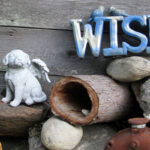Next month, millions of Chinese will head to cemeteries to burn Viagra, brandy bottles, toiletries, tweed shoes, stiletto heels, credit cards, cosmetics, exotic potions, common pain relievers, camcorders, rice cookers, flat screen TVs, cell phones and Mercedes coupes.
These tiny paper offerings are meticulously crafted to resemble real world items. In setting them aflame it is thought the objects will be carried to the afterworld, where they will become available in full form to the recently deceased.
The idea is to provide the dead with everything they will need in the next life, including, in some instances, things that they may never have had in this one. A recent article in the Nanjing Morning News listed some of the more explicit paper offerings being sold, such as condoms and scantily clad barroom dancers.
Tomb Sweeping Festival, or Qingming, on April 5th, is just one of several holidays in which the ritual is performed. Elaborate paper offerings are also burned at the Hungry Ghost Festival, a Buddhist and Taoist holiday that occurs in the summer and offers an opportunity to burn offerings for people who were buried without a funeral.
The Chinese have burnt paper offerings for more than 2,000 years, and an entire ward of Hong Kong paper shops has capitalized on the custom. But both Buddhist monks and the Chinese authorities are not fond of the new trend toward burning paper replicas of luxurious and licentious goods. A Beijing Morning Post article called the practice undignified and rude and called for a clamp down on the sale of sex-oriented offerings. But business is good and a ban seems unlikely.
The practice began at the start of the Wei Dynasty, in the fourth century AD, when Chinese people started burning paper money at funerals. By the Tang Dynasty (618- 907), crafting the paper offerings was a flourishing business. The tradition seems to have been enhanced by a desire for less expensive funerals, notes Harvard researcher Janet Lee Scott, in her 2007 book, “For Gods, Ghosts and Ancestors: the Chinese tradition of Paper Offerings”. Real objects and animals were once offered to the dead, she notes, but during the Song Dynasty (960-1279) inexpensive paper replicas became the norm. Rice paper or a coarse paper made from bamboo was used. Some offerings were flat and two-dimensional while others were wrapped around a bamboo core to create more lifelike 3-D objects.
Paper offerings are also referred to as Joss Paper or Hell Money. Hell money is sold wrapped in cellophane in packs of 30-50. A popular denomination is the 5,000,000,000 dollar bill. On many bills appears an image of the Emperor of the Afterworld, a bearded man in a flat-topped hat strung with beads. The bills’ backside often features the Bank of Hell, an old-fashioned tile-roofed temple. Historic figures that appear on bills include Buddha, John F. Kennedy, Albert Einstein and Marilyn Monroe. A 500 dollar Hell note from Singapore features a phoenix bird and a smiling boy holding a carp.
It is not just China that has recently seen a backlash against the practice. A newspaper article from Vietnam notes that the type of offerings there has shifted from common household items to high-end luxury goods, such as Honda motor scooters, Sony TVs, DVD players and karaoke sound systems.
Two years ago, during Ullambana, a Buddhist festival in which the Gates of Hell are opened so the dead can visit the living, a wealthy Hanoi sand contractor set ablaze more than 1,000 paper people and horses, of which roughly one-quarter were life-size. The display was said to have cost US$21,600 and took a local artisan more than two months to craft.
An article in the Chinese newspaper, “The Global Times” draws another strike against the tradition, forest fires. According to statistics released by the Fire Control Sector of Forestry, 60 percent of fires in the woodlands of Lanzhou, the capital city of Gansu Province, were caused by burning offerings.









